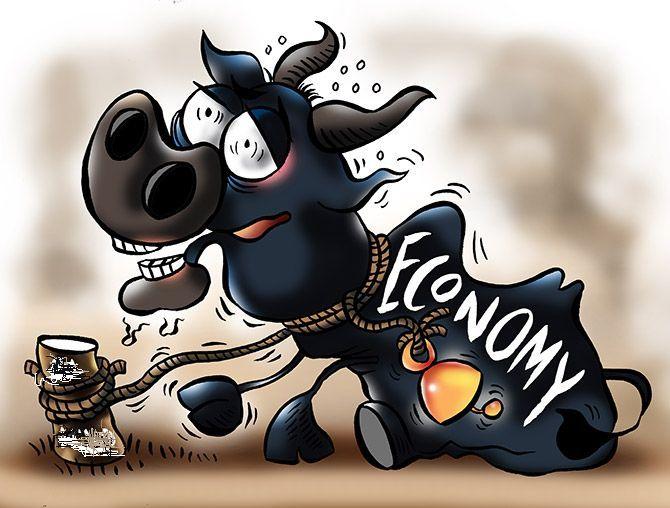The stock market, the Survey felt, had run away from underlying real economy indicators and asked if this indicated rational confidence or irrational exuberance.
Mihir S Sharma checks out the latest Economic Survey.
Illustration: Uttam Ghosh/Rediff.com

In the second volume of the Economic Survey for 2016-17, which was released on Friday, Chief Economic Advisor Arvind Subramanian argued that the Indian economy faced significant short-term concerns, saying it was subject to strong deflationary pressures.
The growth outlook was more subdued than when the first volume was presented just before the Union Budget for 2017-18 in February.
The Survey said all indicators 'pointed to a deceleration in real activity since the first quarter of 2016-17, and a further deceleration since the third quarter.'
The Survey retained its prediction of GDP growth in 2017-18 coming in at between 6.75 and 7.5 per cent, but said that 'outcomes closer to the upper end' were considerably less probable now than they had been earlier.
The Survey also warned that current growth would be difficult to sustain given underlying factors.
The Survey argued that the deflationary trend was part of a broader paradigm shift towards lower inflation, driven by a structural change in the global oil market and transformation of domestic agriculture.
Oil prices, it said, were permanently lower after 2014, and domestic policy changes in the agricultural sector had embedded lower inflation in the Indian economy.
Yet real interest rates, the Survey said, were at 4.7 per cent -- higher than in the recent past, and higher than in comparable economies.
The Survey calculated that current rates were 25 to 75 basis points above the 'neutral' rate, whereas given deflationary conditions they should in fact be below the neutral rate -- so there was ample space for the Reserve Bank of India to cut rates.
The Survey also highlighted the dangers of farm loan waivers, which it said could reduce aggregate demand by as much as Rs 1.1 lakh crore or 0.7 per cent of GDP -- a significant shock to an economy yet to regain momentum.
On demonetisation, the Survey said that 'reliance on cash appears to have declined sharply', with cash holdings being Rs 3.5 lakh crore (20 per cent) less than pre-demonetisation trends.
It noted a substantial increase in digitalisation, saying the 'level and pace' of digitalisation was higher than it had been prior to the demonetisation period.
The Survey said that 540,000 new taxpayers had been added due to demonetisation, or about one per cent of all individual taxpayers.
Meanwhile, it said the short-term impact of demonetisation on GDP and related indicators had 'bottomed out' in past months.
The Survey analysed data from the rural employment guarantee scheme to suggest that the maximum impact on the informal and rural sector was between January and March.
The tax base would also be expanded following the implementation of the goods and services tax, according to the Survey, which highlighted the addition of 660,000 new taxpayers seeking GST registration.
Indirect tax data would also allow for additional information about direct tax collections.
It also noted that the data would be useful to financial institutions for credit rating and loan evaluations, which would aid in the process of financial inclusion.
Growth recovery would be hampered, according to the Survey, by significant stranded assets that would cause balance-sheet problems to continue.
It calculated that 50 per cent of current private sector thermal power plant capacity was simply unviable, and more would become unviable in the medium term.
Another shock to the financial sector might come from the telecom sector, which had vulnerable debt of Rs 1.5 lakh crore.
As a consequence, public sector banks were in 'damage limitation mode' and not seeking out new investments, and growth suffered.
The Survey argued that reform of public sector banks should be a priority.
While growth had proved to be resilient to demonetisation, coming in at 7.1 per cent in 2016-17 -- higher than predicted in the first volume of the Survey -- Subramanian issued a clear warning on the dangers of complacency.
Agriculture and the government contributed one-third of gross value added growth in 2016-17, as opposed to a third the year before.
The Survey calculated that private investment growth would be negative in 2016-17.
Almost all GDP growth in 2016-17 -- 96 per cent -- had come from consumption.
Sustaining such growth would be particularly difficult given that the Survey described the fiscal outlook as uncertain.
Tax compliance following demonetisation and the GST could increase revenues, but the downside risk to the fisc was considerably more considerably more, including higher pay commission expenditures, reduced spectrum receipts, reduced taxes on account of lower GST rates and slow nominal growth.
The Survey argued that India's combination of low real investment, low export volume and low credit growth with high GDP growth was unprecedented and difficult to maintain.
It also noted that asset prices, particularly the stock market, had run away from the underlying real economy indicators, and questioned whether this indicated rational confidence or irrational exuberance.











